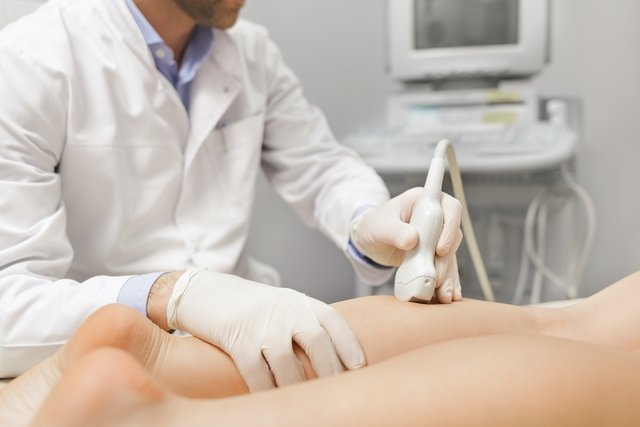Thrombosis is the formation of clots inside veins or arteries, which end up preventing total or partial blood circulation, resulting in symptoms such as pain and swelling in the affected area, loss of strength in the affected limb and pale skin.
The most common type of thrombosis is deep vein thrombosis (DVT), which occurs in the leg veins, but the clot can also affect other parts of the body, such as heart arteries or the brain, being called arterial thrombosis.
Regardless of the type of thrombosis, whenever it is suspected, it is very important to go to the hospital immediately, to confirm the diagnosis and start treatment to restore blood circulation, avoiding more serious complications that can put life at risk.

Symptoms of thrombosis
The main symptoms of thrombosis are:
- Swelling in the leg, arm or hand;
- Decreased movement in the leg, arm or hand;
- Severe pain in the calf, thigh, chest or back;
- Reddish or purplish skin in the affected area;
- Shortness of breath and excessive tiredness;
- Rapid heartbeat;
- Tingling, weakness or paralysis on one side of the body;
- Feeling of fainting and mental confusion.
Furthermore, depending on the location affected by the clot, pain may also appear that radiates to the arm, shoulders or face, a feeling of heaviness in the affected leg and difficulty walking, crooked mouth, difficulty speaking or changes in vision.
In the presence of symptoms that indicate thrombosis, you should immediately seek medical emergency service, so that the doctor can carry out a clinical assessment and start the most appropriate treatment as quickly as possible to avoid complications of thrombosis that can put your life at risk.
Online symptom test
See your risk of thrombosis by selecting your symptoms in the test:
The symptom test is a guidance tool and does not serve as a diagnosis or replace consultation with a cardiologist, hematologist or general practitioner.
How to confirm the diagnosis
The diagnosis of thrombosis is made by a general practitioner, angiologist or vascular surgeon, through the evaluation of symptoms, physical examination, health history, and blood tests, such as complete blood count and D-dimer measurement, in addition to imaging tests, such as ultrasound. or tomography.
Make an appointment with your nearest angiologist to assess your risk of thrombosis:
Taking care of your health has never been easier!
Types of thrombosis
The types of thrombosis vary according to the location of the affected blood vessel, the most common being:
1. Deep vein thrombosis
Deep vein thrombosis (DVT) mainly affects the veins in the legs, usually in a single leg, but can also affect a vein in the pelvis, arm or shoulder, for example.
2. Pulmonary thrombosis
Pulmonary thrombosis or pulmonary thromboembolism: appears when a clot obstructs a blood vessel in the lung, which impairs blood flow in the lungs and gas exchange, resulting in less oxygenation of the body
This type of thrombosis can cause intense symptoms, which can be life-threatening within minutes if not treated immediately.
3. Trombose cerebral
Cerebral thrombosis is one of the serious types of thrombosis, which affects the arteries of the brain, which can result in ischemic or hemorrhagic stroke.
Read too: 12 stroke symptoms (and what to do)
4. Coronary thrombosis
Coronary thrombosis occurs when a clot forms within the coronary artery in the heart, which leads to a decrease in oxygenation of the heart muscle, resulting in a heart attack. See how to identify heart attack symptoms.
5. Kidney thrombosis
Renal thrombosis appears in veins located in the kidneys, preventing or making it difficult for the kidneys to filter the blood and eliminate toxins through urine, and is normally caused by nephrotic syndrome, cancer or trauma to the kidneys.
6. Intestinal thrombosis
Intestinal thrombosis arises in veins in the intestine, leading to interruption of blood to the large or small intestine, and death of intestinal tissue, known as intestinal infarction, resulting in severe abdominal pain, nausea and vomiting.
7. Hemorrhoidal thrombosis
Hemorrhoidal thrombosis occurs when a thrombus is formed that interrupts the flow of blood in the hemorrhoidal vein, which can lead to symptoms such as swelling and intense pain in the anal region.
8. Thrombosis in pregnancy
Thrombosis during pregnancy can occur due to hormonal changes during pregnancy and compression of the uterus on the pelvic blood vessels, making blood circulation in the legs difficult and facilitating the formation of clots. Know how to identify the symptoms of thrombosis during pregnancy.
9. Placental thrombosis
Placental thrombosis is a type of serious thrombosis that occurs when a clot forms in the veins or arteries of the placenta, impairing the blood supply to the baby and causing a decrease in fetal movements.
This type of thrombosis must be treated immediately in the hospital and can increase the risk of miscarriage or premature birth.
10. Contraceptive thrombosis
Contraceptive thrombosis can arise due to the estrogen present in pills, injections, implants or patches, for example, as it stimulates the production of clotting factors by the liver, increasing the risk of clot formation.
11. Thrombophlebitis
Thrombophlebitis is an inflammation of a superficial blood vessel and the formation of a clot inside the vessel at the same time, causing localized swelling and redness in the affected vein, which causes a lot of pain on palpation. Learn more about thrombophlebitis.
Possible causes
The main causes of thrombosis are:
- Family or personal history of thrombosis;
- Diabetes, obesity or overweight;
- Pregnancy;
- High cholesterol and/or triglycerides;
- Blood disorders such as thrombophilia;
- Smoking habit;
- Spending a very long period of rest, whether lying down or sitting, such as after surgery or plane travel.
Furthermore, cardiovascular changes, such as arrhythmias, cardiomyopathies, high blood pressure and atherosclerosis, lung diseases, Crohn’s disease, or use of a central venous catheter can also increase the risk of thrombosis.
Other causes are estrogen treatments, such as contraceptives or hormone replacement therapy, or the use of medications that interfere with clotting.
How the treatment is carried out
The treatment of thrombosis must be carried out under the guidance of a general practitioner, angiologist or vascular surgeon, with the aim of preventing the formation or growth of clots, or preventing existing clots from detaching from the affected blood vessel and being taken to other parts of the body, causing embolism.
Therefore, the main treatments that can be recommended by the doctor for thrombosis are:
1. Use of medicines
The main remedies that may be indicated for the treatment of thrombosis are:
- Oral anticoagulants, such as warfarin or rivaroxaban;
- Injectable anticoagulants, such as heparin or enoxaparin;
- Antiplatelet agents, such as acetylsalicylic acid;
- Statins, such as rosuvastatin, to lower cholesterol and prevent recurrence of deep vein thrombosis.
Furthermore, thrombolytic medications, such as streptokinase, alteplase or tenecteplase, may be indicated in severe cases, and are performed in hospitals for the treatment of emergencies.
In some cases, it is necessary to be hospitalized to adjust medication doses and perform other tests.
2. Surgery
Surgery for thrombosis aims to remove the clot and reestablish blood circulation in the area, which can be done through thrombolysis, which consists of introducing a catheter into the blood vessel with medication to dissolve the clot.
Other surgical techniques are percutaneous aspiration thrombectomy and balloon angioplasty. Understand how angioplasty is performed.
3. Daily care
After the initial period, it is also recommended to take some precautions, such as avoiding sitting with your legs down and always wearing elastic compression socks, such as Kendall socks, as this reduces the risk of clot formation. Check out more details about treatment options for thrombosis.
Read too: 4 home remedies for thrombosis (and how to do them)
How to prevent
Thrombosis prevention can be done through a healthy diet, good hydration and regular physical exercise, which improves blood circulation, reduces inflammatory processes and prevents the accumulation of fatty plaques in blood vessels.
For people who have varicose veins, circulatory problems or who remain seated for a long time, it is recommended to use elastic compression stockings.
Read too: How to reduce the risk of thrombosis after surgery
Furthermore, in situations where it is necessary to remain still for a long time, such as in the case of bedridden people, it is recommended to change the person’s position regularly, at least every 2 hours. See other tips on how to avoid thrombosis.
Furthermore, when traveling, the person should get up every hour and walk a little, in order to facilitate blood circulation.
Watch the following video with other tips that can help avoid thrombosis during travel:
Possible complications
The main complications of thrombosis are:
- Pulmonary hypertension;
- Intracranial hemorrhage;
- stroke or transient ischemic attack (TIA);
- Heart attack;
- Ischemia, gangrene and intestinal perforation.
Furthermore, another complication is post-thrombotic syndrome caused by deep vein thrombosis, when treatment is carried out inadequately, causing chronic pain or a feeling of heaviness, swelling or cramps in the leg that worsen during exercise and improve at rest.

Sign up for our newsletter and stay up to date with exclusive news
that can transform your routine!
Warning: Undefined array key "title" in /home/storelat/public_html/wp-content/plugins/link-whisper-premium/templates/frontend/related-posts.php on line 12
Warning: Undefined array key "title_tag" in /home/storelat/public_html/wp-content/plugins/link-whisper-premium/templates/frontend/related-posts.php on line 13



